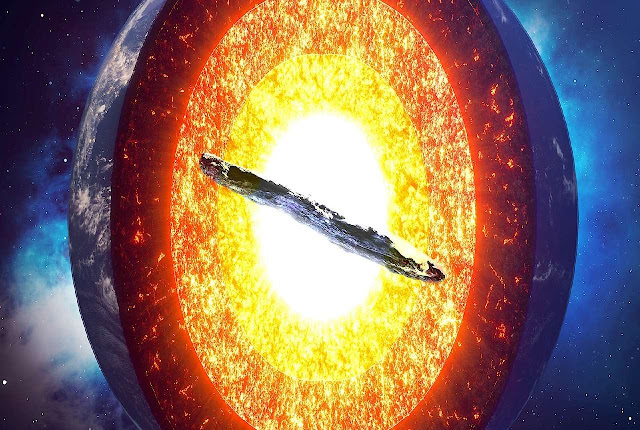
How and where did the Earth start to form? According to current models, the entire Solar System has gradually formed from the same mass of matter. First the Sun, then the planets - including the Earth - and small celestial bodies. But a new study suggests that the "first rock" in space that allowed Earth to form could have formed in the environment of another star. In this hypothesis, it would therefore be only after the Sun would have received this first part, around which the matter of the protoplanetary disc of the Sun would have agglomerated to form the planet on which these lines are written.
According to the very old model called "solar nebula hypothesis", the partial gravitational collapse of a giant molecular cloud would have given birth to our solar system, around 4.55 billion years ago. The Sun would then be born in the center of the collapse zone, around which the protoplanetary disk - a disk of gas and dust that surrounds a young star (a "soup" in which bodies can form) - has kindly taken hold, within which the planets and other celestial objects (moons, asteroids, etc.) were formed.
This modeling is now widely accepted and also applies to the entire Universe, but certain details such as the formation and exact evolution of specific primitive objects on which certain planets formed remained subject to debate.
How could we be sure that the first rocks that gave birth to the Earth all came from our solar system? At least for now, we can't be… And that's where the research team of Amaya Moro-Martín and Colin Norman, from the Space Telescope Science Institute in Baltimore (United States) comes with his new study (not peer reviewed), by further exploring the possibilities of extrasolar provenance of the first "seeds" that allowed the formation of planets and other bodies within the Solar System.
Are we debtors of the first building blocks of the Earth?
According to the study's findings, interstellar objects may well have seeded the formation of planets in solar systems like ours, which could solve a key problem in various theories of planet formation.
Even today, the more or less regular detection of foreign objects suggests that many interstellar bodies are traveling around us and could invite themselves into our solar system at any time. The interstellar object 'Oumuamua', detected in 2017, is a perfect example. Initially, the hypotheses were broad and included a probable asteroid or comet ejected from its host star system. According to recent studies, however, it is rather a piece of nitrogenous ice from an exo-Pluto (a pluto-like dwarf planet located outside the Solar System).
Furthermore, these exchanges of primitive celestial bricks suggest that such objects could play a role in the formation of star and planetary systems. The slow speed of young stars relative to their neighbors, coupled with the "braking effect" of the dust and gas surrounding them, could cause these objects to orbit a star rather than simply pass through it, as 'Oumuamua did.
Hundreds of billions of interstellar objects captured every 10 million years
In their new study, available on the arXiv preprint server, the researchers modeled this process to estimate how many objects could be trapped by an average young star. They suggest that, over a period of about 10 million years: 600 billion objects of about 1 meter would be captured; 200 million objects 10 meters wide; 60,000 of 100 meters wide and 20 of 1 kilometer wide.
Surprisingly high figures, but very uncertain according to the study. Indeed, the researchers specify that it remains to this day difficult to estimate the exact quantity of matter involved in the mathematical models which have made it possible to achieve this. But the conclusions of the study nevertheless make it possible to suggest that interstellar objects could indeed "seed" the birth of the planets.
According to current theories, planets are formed by the accumulation of matter obtained either by accretion of small centimetric objects called floccules, or by the collision of asteroid-like bodies, called planetesimals. But concerning the first possibility of formation, when the solid bodies (floccules) have reached a few centimeters or decimeters, the growth models by collisions encounter a major problem, which is called “the meter barrier”. This question therefore also leaves a certain freedom to the theories of planetary formation.
Why are these objects of a few centimeters a problem in this model? Quite simply because with such sizes, the collisions become more energetic, too energetic to allow easy aggregation of matter. In other words, these large particles then tend to "repel" rather than aggregate.
This is where the theory on which the new study is based becomes interesting: unlike floccules, interstellar objects, larger and massive, allow this matter to condense. Their mass is sufficient to capture more material, while being strong enough to withstand powerful impacts with other pieces of material.
According to the researchers, these newly formed objects are sometimes ejected from their original system, and can thus be recovered by a next generation of planetary systems. This could therefore indicate that we owe our existence to matter from another star. In other words, it is possible that the Earth was formed from an interstellar object located in the protoplanetary disk of the Sun. Today, this object would therefore form only a tiny part of the mass of our planet and would almost certainly not be detectable.





No comments:
Post a Comment